Fery
National Hazard
   
Posts: 990
Registered: 27-8-2019
Location: Czechoslovakia
Member Is Offline
|
|
hydrazobenzene
I start this thread with an unsuccessful experiment which did not produce hydrazobenzene, but azobenzene instead for some mysterious reason. I followed the steps from the azobenzene thread - vogel1958.pdf, the steps are similar in both experiments, just here twice of Mg is used for the reduction.
I even used not only 48g but 53,4 g as after 48 g I was not satisfied with the final color of the reaction... seems Mg + CH3OH were not powerful
enough in my experiment to reduce azobenzene further to hydrazobenzene...
here the experiment:
25,6 g nitrobenzene was put into 1 L FBF with stirbar and 350 ml of methanol (water content max 0,1%, as I wrote in azobenzene thread water content
max. 0,01% would be better but no matter), small crystal of iodine and Mg turnings in 6 g portions. The reaction was heated because I used not
completely dry methanol and old Mg not anymore brightly shiny but already grayish which I just crushed in mortar with pestle - using absolute methanol
and better Mg the reaction may start spontaneously in few minutes and get too vigorous, in such case you should cool the flask. The reaction started
and was refluxing under Liebig condenser (max upto 2 drops per second observed returning from the condenser, the rate seems to depend on the Mg
surface area and the stirring too). The mixture was stirred at max. RPM (to scratch the Mg surface as much as possible and to remove Mg(OH)2 from the
Mg surface as quickly as possible). Mg was added continually in 6 g portions after the reflux subsided, which was in my case in 30 minute intervals.
After few portions of Mg added the reaction mass was very thick due to Mg(OH)2 formation, I repeatedly (IIRC 2-3 times) added methanol (somewhat upto
extra 200 ml - in this case once the reaction starts, further usage of small amounts of not absolutely dry methanol does not cause problems as the
water is immediately destroyed by Mg(CH3O)2 + 2 H2O -> Mg(OH)2 + 2 CH3OH).
After 48 g of Mg was introduced the reaction was not colorless but still yellow so I added extra 5,4 g of Mg. The Mg used for the reaction weighed
53,4 g totally (vogel1958.pdf is satisfied with 48 grams). When reaction subsided the heating was turned on and it was refluxed for 1 hour still
stirring at max RPM. The reaction mass did not lose color anyway and was yellow. After allowing to settle the Mg(OH)2 the upper liquid layer was even
red. When mixed the settled fine Mg(OH)2 again caused the mass to become yellow colored (see pictures).
200 ml of boiled and then cooled water was added (repelled dissolved O2) which decomposed Mg(CH3O)2. Then glacial acetic acid was added dropwise while
stirring (somewhat like 250-300 ml) which dissolved Mg(OH)2 (heat evolved, exothermic, do it slowly or cool the reaction). Then 100 ml of cold
deoxygenated water was added into stirred hot solution at which point it started to be turbid (crystallization of the product). It was put into cold
water bath and later into fridge at +4 C overnight.
The next day the crystals were separated by vacuum filtration on Buchner funnel (cold methanol from diluted solution still had a tendency to boil,
only water aspirator was used with approximate vacuum level -0,9 atm, at most 0,95 atm, certainly not more, I suggest to use not too much dense filter
paper. Btw filtering the Mg(OH)2 in methanol (as stated in vogel1958.pdf) is impossible due to methanol boiling at low pressure and fine Mg(OH)2
clogging the filter paper completely, Mg(OH)2 must be destroyed by acetic acid as stated in prepchem - see the reference later.
These crystals were again red. Hydrazobenzene should be colorless with only little yellowish discoloration due to surface oxidation to azobenzene.
Product obtained resembles the already well known azobenzene. I'll recrystallize it the same way as in azobenzene thread.
To prepare hydrazobenzene I suggest to use Zn + NaOH instead of Mg.
And ethanol should be used instead of methanol, I found this information, that methanol causes there again only azobenzene formation:
https://www.vedantu.com/question-answer/the-product-obtained...
| Quote: | Note: when nitrobenzene is treated with methanolic solution of zinc and sodium hydroxide then, azobenzene is formed, this happens because alcohol,
removes the hydrogen present in amine and convert to simple nitrogen resulting in the azobenzene. The reaction is:
2 C6H5−NO2 (nitrobenzene) + Zn + NaOH + CH3OH → C6H5−N=N−C6H5 (azobenzene) |
in prepchem they used anyway methanol + Zn + NaOH:
https://www.prepchem.com/synthesis-of-benzidine/
| Quote: | | 105 g of sodium hydroxide are dissolved in 300 ml of water. To this solution a mixture of 50 ml methanol, and 100 g of nitrobenzene are added. The
reaction flask is fitted with a reflux condenser and the zinc dust, which must have been passed through a fine sieve, is added in small portions. It
is very important that the reaction flask should be thoroughly well stirred after each addition portion of zinc, and, indeed, throughout the
experiment. After addition of zinc dust a vigorous reaction take places and the mixture boils. The mixture is kept boiling by successive additions of
zinc. Quick addition of zinc dust should be avoided in order to prevent foaming. The brown color gradually disappears, and when the reduction is
complete the contents of the flask should appear grayish white. If this effect is not produced at this stage, additional portion of zinc dust may be
added, and the flask heated till reduction is complete. The reaction mixture is cooled, diluted with distilled water, ice added, and the reaction
mixture carefully acidified with hydrochloric acid, not allowing the temperature to rise above 15° C. The hydrazobenzene separates out in crusts,
which are easily separated from the liquid, and any zinc remaining undissolved is separated by pouring the reaction mixture through a porcelain funnel
without paper. The separated hydrazobenzene is additionally washed with water. Then hydrazobenzene is converted into benzidine by boiling with 300-400
ml of water and adding concentrated hydrochloric acid gradually as long as HCl is absorbed. Finally, the hydrochloric acid solution is allowed to boil
for a few minutes longer and the solution of benzidine hydrochloride is filtered. To the filtrate sulfuric acid is added, to precipitate the benzidine
as sulfate. This is filtered, washed, and boiled with dilute NaOH solution. The solution of the benzidine base is filtered, and the benzidine
crystallizes out on cooling, which is filtered, and dried yielding 20-30 g of final product. Further purification is performed by crystallizing from
hot water. Benzidine crystallizes from hot water in large silky plates which melt at 122° C. |
so I'm confused what's wrong, whether Mg or methanol or both or absence of alkaline environment 
OK the pictures:
25,6 g nitrobenzene + stirbar in 1 L flat bottom flask on magnetic stirrer
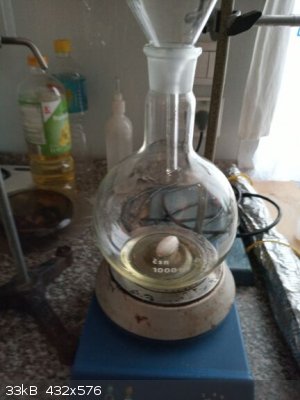
25,6 g nitrobenzene + 350 ml of methanol + small crystal of I2 + 6,0 g of Mg turnings, the reaction did not yet start (too much water in methanol +
too old Mg), to start it I had to heat it, once the reaction started it will be going (no traces of water anymore)
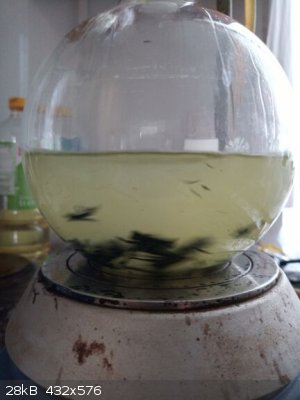
still azobenzene visible
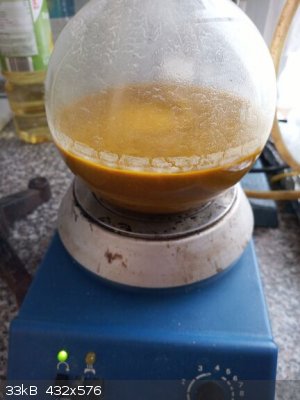
although less red and only yellow color it seems promising, but... (see the next picture)
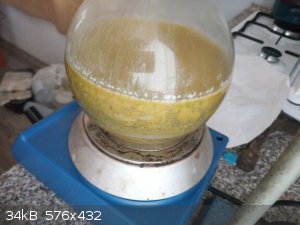
after settling the Mg(OH)2 which masked the real color, the truth revealed (red = azobenzene = not good), note during the half of day of the fine
Mg(OH)2 settling down the apparatus was tightly stoppered to prevent air entering the apparatus and oxidize (hypothetically present) hydrazobenzene
back to azobenzene, in this picture there seems to be some mysterious harware error caused by my photo device (upper half is darker and more sharp)
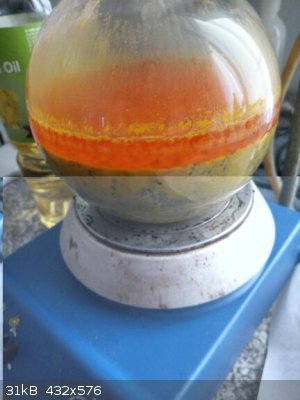
crystals of crude azobenzene and their filtration, the product will be later recrystallized the same way as in azobenzene thread and I will try to
prepare hydrazobenzene with Zn+NaOH, maybe methanol as in prepchem or maybe ethanol
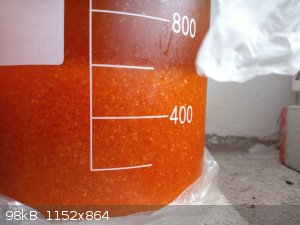 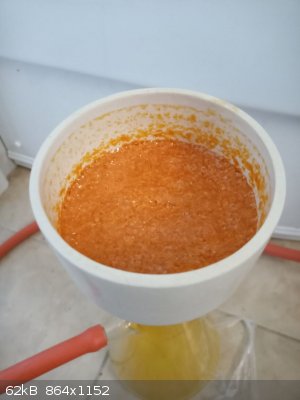
|
|
|
Fery
National Hazard
   
Posts: 990
Registered: 27-8-2019
Location: Czechoslovakia
Member Is Offline
|
|
NO HYDRAZOBENZENE OBTAINED, ONLY AZOBENZENE
the wet product was transferred into 1 L FBF on magnetic stirrer with 250 ml of H2O, added slowly 100 ml of 35% HCl while stirring, stirred for 1 hour
at room temperature, 1 hour at 45 C (benzidine rearrangement would occur if there was some hydrazobenzene present, hydrazobenzene dihydrochloride
would dissolve in the warm solution), then filtered using Buchner funnel:
azobenzene in fine particles stayed on the filter, to the filtrate added 50 ml of conc. H2SO4, cooled in fridge overnight at +4 C, nothing
crystallized (no benzidine sulfate obtained), filtrate discarded
the azobenzene from Buchner funnel was recrystallized from 150 ml of 85% isopropanol - dissolved in boiling solvent, filtered while hot, slowly cooled
down to room temperature, introduced small dust crystal which initialized crystallization, put into fridge overnight to +4 C, vacuum filtered, washed
twice with 10 ml of +4 C cold 85% isopropanol, air dried in dish, got orange-red scales
yield 11,5 g
m.p. 67-67,5 C
the mother liquor + washings further cooled in freezer to -18 C overnight, vacuum filtered, yield 0,9 g m.p. 65,5-67 C (not worth of doing it, I just
tried...)
reaction with 10% HCl (hydrazobenzene would undergo benzidine rearrangement and dissolve as dihydrochloride)
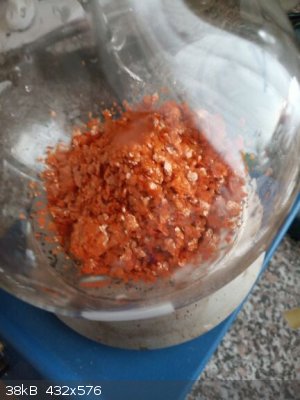 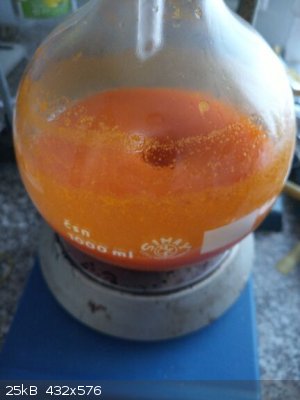 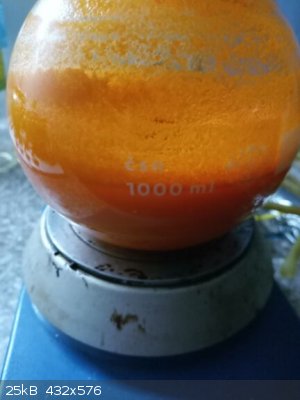
filtration (only azobenzene on the filter paper obtained, no benzidine in the filtrate)
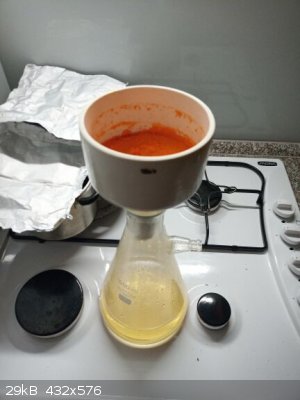 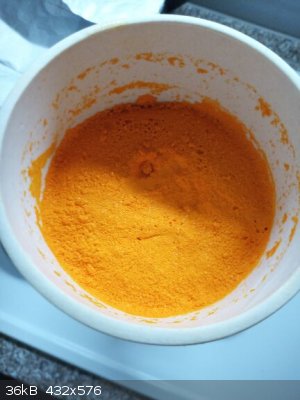 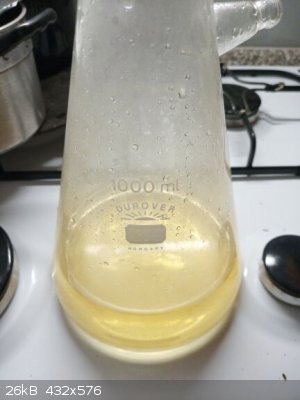
filtration of azobenzene dissolved in 85% isopropanol
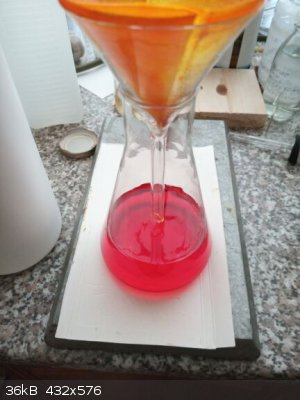
crystals of azobenzene in form of scales
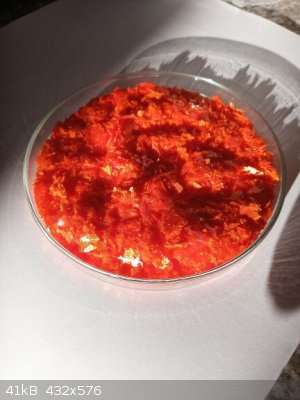 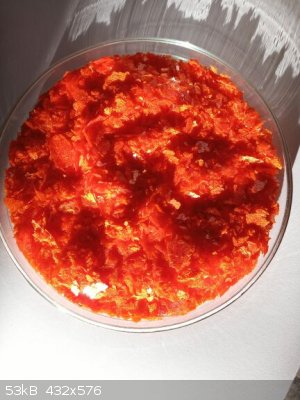 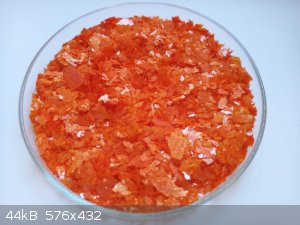
|
|
|
Triflic Acid
Hazard to Others
  
Posts: 486
Registered: 27-9-2020
Member Is Offline
Mood: Slowly Oxidizing into Oblivion
|
|
Have you tried hydrogenating the azobenzene. I would think you have a good amount of it by now. Hydrogenating nitrobenzene also seems to work, check
US4326078A. Also, those crystals look pretty nice. Must be one of the nicest looking failures. Are they photochromic?
There wasn't a fire, we just had an uncontrolled rapid oxidation event at the power plant.
|
|
|
Fery
National Hazard
   
Posts: 990
Registered: 27-8-2019
Location: Czechoslovakia
Member Is Offline
|
|
Hi Triflic Acid
here also video of growing crystals
https://www.youtube.com/watch?v=hmVhk7p89NU
the solution tends to be supersaturated, but introducing small crystal (small grain of dust saved previously) triggers the crystallization (filtration
prior that is necessary to remove all crystallization centers and use new glass without scratches)
interesting that from 85% IPA the crystals are scales / leaves / 2-dimensional (the third dimension very thin) and from 90% ethanol normal space
crystals = 3 dimensional
the cis/trans form is interesting and described here:
https://en.wikipedia.org/wiki/Azobenzene
UV light should be able to convert more stable trans form into cis form
according the m.p. 67-67,5 C I got the stable trans form m.p. 67,88 C while the less stable cis form has m.p. 71,6 C
|
|
|
vibbzlab
Hazard to Others
  
Posts: 241
Registered: 6-11-2019
Member Is Offline
Mood: Always curious
|
|
I followed Vogel's too just now and received azobenzene only. I couldn't get hydrazobenzene. I think we'll have to do it in inert atmosphere like
nitrogen or argon
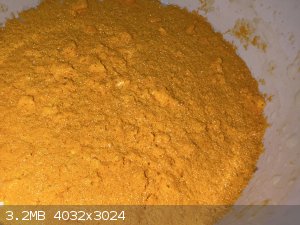
Amateur chemist. Doctor by profession
Have a small cute home chemistry lab.

Please do check out my lab in YouTube link below
This is my YouTube channel |
|
|
Fery
National Hazard
   
Posts: 990
Registered: 27-8-2019
Location: Czechoslovakia
Member Is Offline
|
|
There is enough H2 so the atmosphere is inert. I used old Mg for Grignard (already gray instead of shiny), maybe I had to activate it in dil. 1% HCl.
Or maybe I had to use more I2, I used only one very tiny crystal. Later I bought enough of p-benzidine so I did not investigate this reaction further.
I used freshly bought analytical grade methanol with only traces of water max. 0,05 %:
https://sklep-chemland.pl/en/metanol-alkohol-metylowy-purela...
https://sklep-chemland.pl/media/products_pdf/48765_Cert_Meta...
https://sklep-chemland.pl/media/products_pdf/48765_PG_Metano...
Using methanol with more water makes the reaction slower, especially the start is delayed until H2O consumed.
Nitrobenzene was also dry and superior quality, directly from the factory where my friend Bedlasky is working.
Magpie succeeded in this reaction:
https://www.sciencemadness.org/whisper/viewthread.php?tid=65...
|
|
|
|